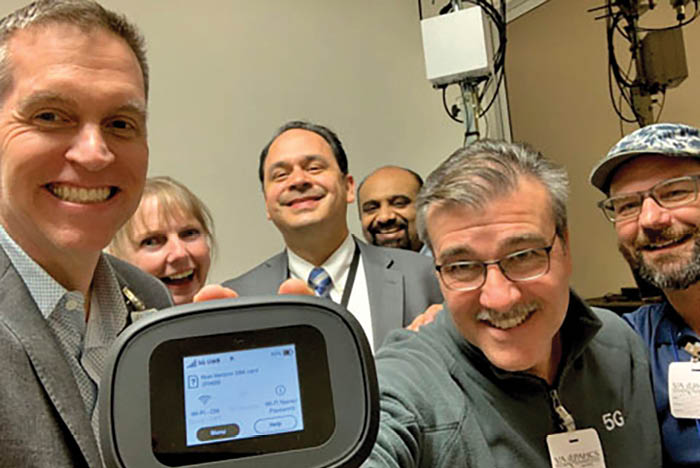Early 5G deployments poised to transform health care delivery

VA Palo Alto team celebrates shortly after establishing the first 5G signal.
Image courtesy of VA Palo Alto
The health care field is moving toward a digital transformation, eager to embrace the possibilities big data offers for diagnosis, treatment and health management. The greatest hurdle to achieving these possibilities may lie in dated infrastructure unable to support those lofty goals. That’s changing as health care leaders invest in 5G infrastructure and partner with experts to determine how best to utilize this upgraded infrastructure.
5G — or fifth-generation cellular networks — offer faster speeds, reduced latency for greater responsiveness and better security than previous generation networks. This increases download speeds by 10 to 100 times what’s possible with 4G LTE and allows users to connect more devices, a critical step in supporting “internet of things” connectivity that allows devices to “talk” with one another.
Hospitals are finding this infrastructure can take two forms, either as physical fibers installed through a facility or through use of a portable unit, what Verizon calls a “network on wheels.”
Emory Healthcare, Atlanta, has installed the former. Emory partnered with Verizon to deploy a 5G Ultra Wideband (UWB) network within its Innovation Hub. It is working with Verizon and 11Ten Innovation Partners, Atlanta, which oversees the operation of the hub, to research, design and develop new health care solutions. The researchers actively seek industry partners and startups to co-develop 5G-based health care technologies, with plans to commercialize for production by 2021.
“The Emory Healthcare Innovation Hub’s Verizon 5G UWB network brings a faster and more secure network that can accommodate more devices and higher computer speeds,” says James Lewis, co-founder and CEO of 11Ten Innovation Partners. Hub researchers are exploring a range of possible use cases. Possibilities include augmented and virtual reality to support more accurate medical training, pre-surgical planning and remote physical/behavioral therapies; robot-assisted surgery; and internet of medical things connectivity for connected ambulances, remote patient monitoring, telehealth and in-patient monitoring.
California-based VA Palo Alto Health Care System is taking a narrower focus with its development of the country’s first 5G hospital. It installed a portable 5G network solution within its education building with the goal of relaying that signal throughout the campus by year’s end. It aims to implement 5G capabilities into surgical care, and the VA has announced a partnership with Verizon, Microsoft and Medivis, Brooklyn, N.Y., a technology company using augmented reality and artificial intelligence to develop software for computer-assisted surgery.
Medivis developed a SurgicalAR software for the Microsoft HoloLens in early 2019. The Food & Drug Administration-approved platform maps medical imaging information onto the patient, giving surgeons a 3D view of the data. The software is responsive to gesture and voice commands, allowing surgeons to access different levels of imaging data while keeping their hands sterile.
“Holographic visualization is the final frontier of surgical imaging and navigation,” says Osamah Choudhry, Medivis CEO and assistant professor of neurosurgery at NYU Langone Health.
Choudhry’s forecast may perhaps come true, but the “last mile problem,” as the Federal Communications Commission (FCC) calls the challenge of getting internet access to rural communities, is also ripe for a 5G solution. A paper published in the January 2020 issue of the Journal of Appalachian Health, “Barn-Raising on the Digital Frontier: The L.A.U.N.C.H. Collaborative,” by the FCC and other researchers outlines an analysis of oncology papers that identified a trend in cancer patients who lived more than 50 miles away from a hospital center. These patients “routinely presented with more advanced stages of disease at diagnosis, exhibited lower adherence to prescribed treatments, presented with poorer diagnoses, and reported a lower quality of life than patients who lived nearer a hospital.”
To address these types of challenges, the FCC has proposed a $9 billion 5G Fund for Rural America. The $8 billion Phase 1 deployment seeks to fill in coverage for areas unlikely to see service under T-Mobile’s commitment to deploy its 5G network to 90% of rural Americans by 2026. Phase 2 would target at least $1 billion to support harder-to-serve areas.
To frame the relation between connectivity and health, the FCC Connect2Health Task Force released “Mapping Broadband Health in America,” an interactive mapping platform that allows users to visually analyze broadband and health data at national, state and county levels.
While the FCC is now reviewing comments on its implementation approach, it’s clear that the deployment of 5G to rural areas presents lifesaving implications. As the researchers put it in The Journal of Appalachian Health, “Connected health approaches — or the use of broadband and telecommunications technologies to evaluate, diagnose and monitor patients beyond the clinic — are becoming an indispensable tool in medicine to overcome the obstacle of physical distance.”




